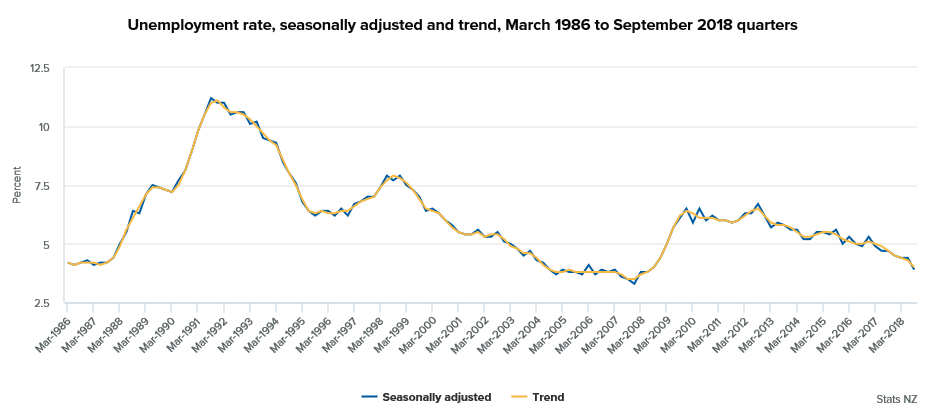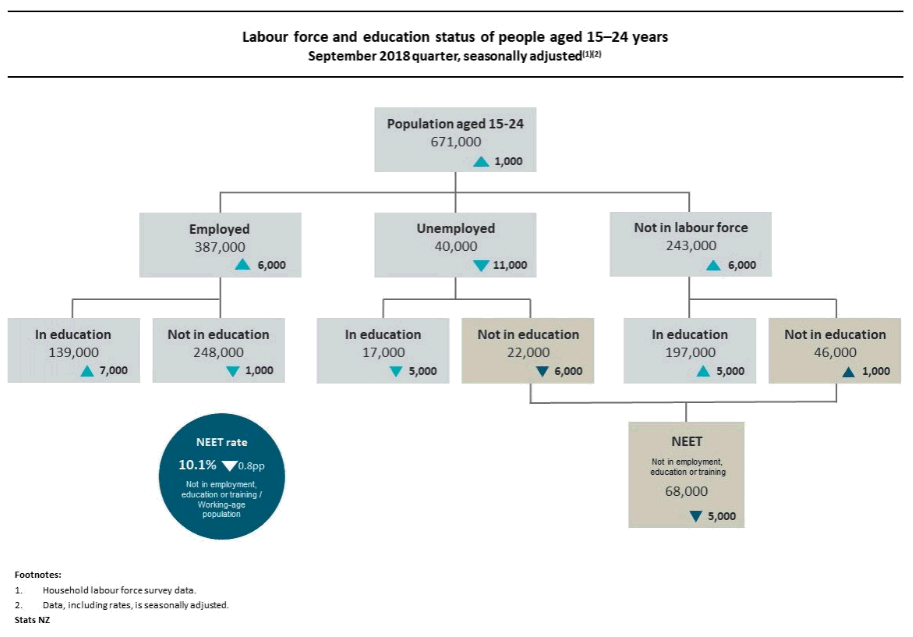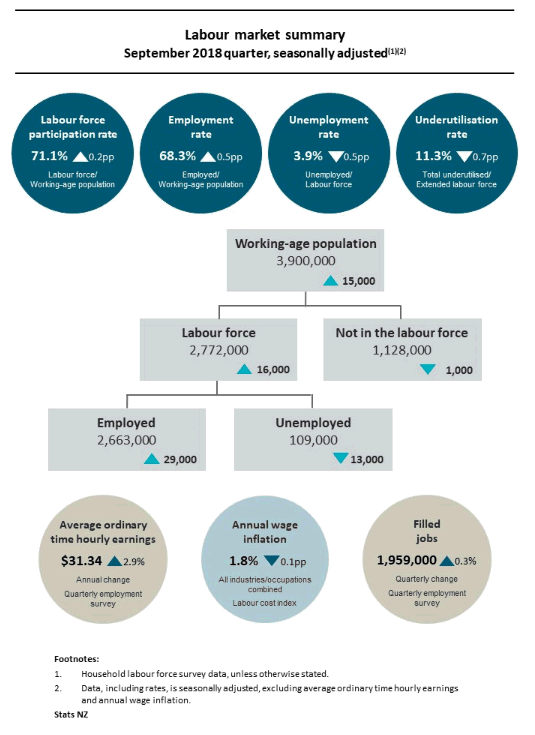Unemployment rate falls to 3.9 percent
The seasonally adjusted unemployment rate fell to 3.9 percent in the September 2018 quarter, Stats NZ said today.
This is down from 4.4 percent last quarter and is the lowest unemployment rate since the June 2008 quarter, when it was 3.8 percent.
The fall in the unemployment rate in the latest quarter reflected a fall in the number of unemployed people (down 13,000) and a strong rise in employment (up 29,000). This quarter’s employment rate rose to 68.3 percent, the highest rate since the series began more than 30 years ago.
The fall in unemployment, in tandem with a fall in underemployment, was key to the underutilisation rate falling to 11.3 percent.
“While this quarter’s unemployment rate is outside market expectations, we know New Zealand has a small economy with a dynamic labour market, and large changes, both up and down, have happened before – in late 2012 and 2015,” labour market and household statistics senior manager Jason Attewell said.
“We also know labour market measures tend to lag behind other economic indicators, which have shown strong and widespread growth in 2018. We’ve seen population growth in the regions, reports of more job ads, high levels of migration and tourism, growing retail sales, and rising exports.”

“Labour market data is most valuable when placed in the context of a time series. The trend series, which reveals the underlying direction of movement, has now fallen for seven consecutive quarters,” Mr Attewell said.
The likelihood that someone would move out of unemployment, from one quarter to the next, rose in the September 2018 quarter when compared with previous September quarters.
A tight labour market can lead to low unemployment – when demand for workers increases to the point where people who are not in the labour force, or are unemployed, secure employment almost immediately on wanting a job.
In the latest quarter, 109,000 people were unemployed – 13,000 (10.5 percent) fewer than in the June 2018 quarter, with 8,000 fewer women and 5,000 fewer men. For both sexes, this mainly reflected 11,000 fewer unemployed youth (15–24-year-olds).
There were 6,000
fewer youth unemployed and not in education, which led to
the not in employment, education or training (NEET) rate
falling to 10.1 percent. The fall in NEET youth was
primarily influenced by men and women aged 20–24 years.
There were also:
• 5,000 fewer youth who were
unemployed and in education
• 7,000 more youth in
education and employment
• 5,000 more youth in
education and not in the labour force.

In the year to the September 2018 quarter, 73,200 (unadjusted) more people, as measured by the household labour force survey (HLFS), were employed (up 2.8 percent) – 45,200 more women and 28,000 more men.
These regions had significant
employment growth:
• Auckland – up 34,600 (3.8
percent)
• Waikato – up 8,400 (3.3 percent)
• Otago – up 6,700 (5.5 percent)
• Gisborne/Hawke’s Bay – up 6,400 (6.5 percent)
• Taranaki – up 4,300 (7.1 percent).
Annually, filled jobs, as measured by the quarterly employment survey (QES), increased 1.2 percent (unadjusted) – 23,500 more jobs. Of this increase, 17,500 were held by women and 6,000 by men.
Differences between filled jobs in the QES and employment numbers in the HLFS can largely be explained by differences in survey coverage. The QES excludes some industries (including agriculture), and those who are self-employed without employees (to better fit international standards). Conversely, the HLFS only includes usually resident New Zealanders, so can exclude some temporary seasonal labourers.
The labour cost index (LCI) increased 1.8 percent in the year to the September 2018 quarter, while the analytical unadjusted LCI increased 3.3 percent. Private sector wages increased 1.9 percent, while public sector wages increased 1.5 percent.
Within the QES, wages also grew annually. Average ordinary time hourly earnings increased to $31.34 (up 2.9 percent). Private sector average ordinary time hourly earnings increased 3.6 percent, to $29.38, while for the public sector the increase was 1.6 percent, to $39.31.
Average weekly earnings (including overtime) for full-time equivalent employees (FTEs) also increased annually, up 3.3 percent to $1,212.82 per week.

Text alternative for Labour market summary diagram, September 2018 quarter, seasonally adjusted
Video
See the Labour market statistics: September 2018 quarter video.
Ends and


 Federated Farmers: Government Ends War On Farming
Federated Farmers: Government Ends War On Farming University of Auckland: NZ Researchers Drive Work On International AI Framework
University of Auckland: NZ Researchers Drive Work On International AI Framework Woolworths: Rolling Out Team Safety Cameras To All Stores As Critical Tool For De-escalating Conflict
Woolworths: Rolling Out Team Safety Cameras To All Stores As Critical Tool For De-escalating Conflict  Consumer NZ: Environmentally Conscious Shoppers At Risk Of Being Greenwashed
Consumer NZ: Environmentally Conscious Shoppers At Risk Of Being Greenwashed Hugh Grant: Facing The Future - The Use Of Biometric Tech
Hugh Grant: Facing The Future - The Use Of Biometric Tech John Mazenier: Gaffer Tape And Glue Delivering New Zealand’s Mission Critical Services
John Mazenier: Gaffer Tape And Glue Delivering New Zealand’s Mission Critical Services



